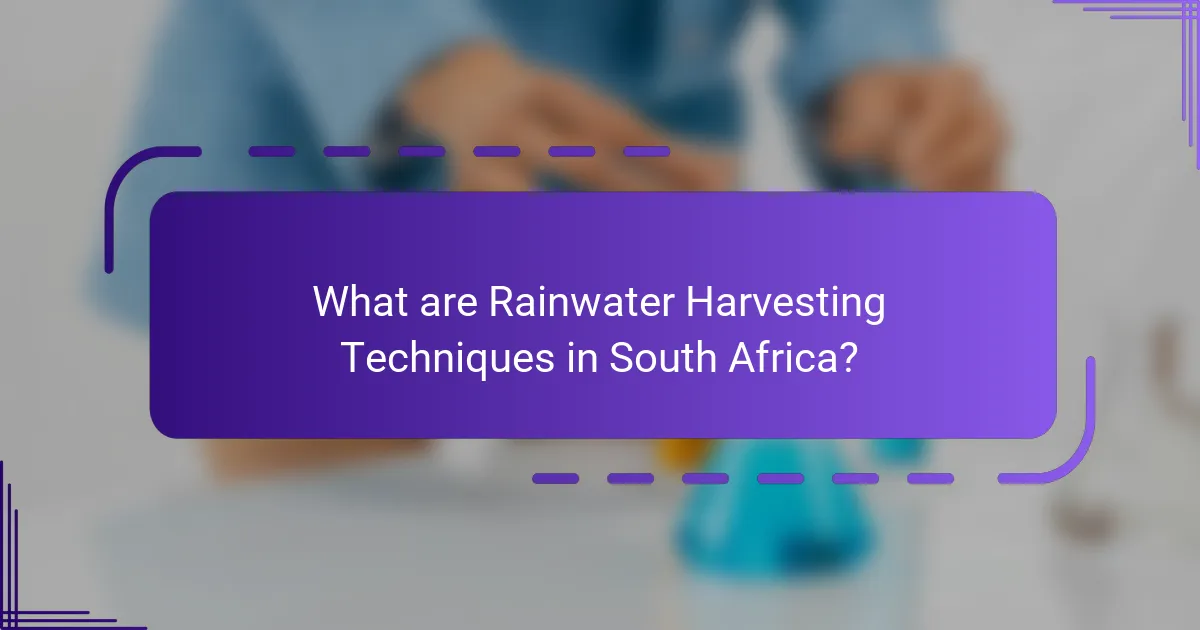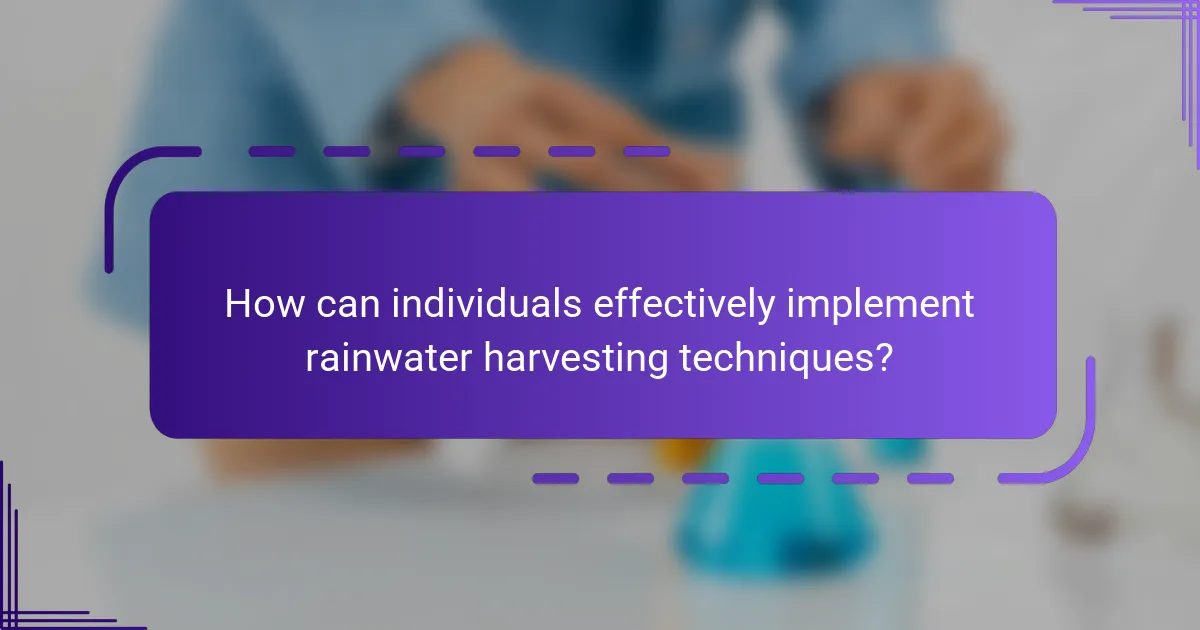Rainwater harvesting techniques in South Africa encompass rooftop collection, surface runoff harvesting, and subsurface collection. Rooftop collection directs rainwater from roofs into storage tanks, primarily in urban areas, while surface runoff harvesting captures water from land surfaces for agricultural use. Subsurface collection employs underground reservoirs to minimize evaporation losses. These methods are governed by the National Water Act of 1998 and local regulations, ensuring safe and sustainable practices. Individuals can implement these techniques through proper installation and maintenance of rainwater collection systems, which significantly reduce municipal water demand and promote sustainable water use.

What are Rainwater Harvesting Techniques in South Africa?
Rainwater harvesting techniques in South Africa include rooftop collection, surface runoff harvesting, and subsurface collection. Rooftop collection involves directing rainwater from roofs into storage tanks. This method is widely used in urban areas. Surface runoff harvesting captures water from land surfaces, utilizing swales or ponds. It is effective in agricultural settings. Subsurface collection involves the use of underground reservoirs to capture and store rainwater. This technique helps reduce evaporation losses. Each method is tailored to local climate conditions and water needs. According to the Department of Water and Sanitation, these techniques can significantly enhance water supply in water-scarce regions.
How do these techniques work in practice?
Rainwater harvesting techniques in South Africa work by collecting and storing rainwater for various uses. These techniques typically involve the installation of systems that capture runoff from roofs and other surfaces. The collected water is directed through gutters into storage tanks. The tanks can be made of various materials, including plastic, concrete, or metal, and are designed to hold significant volumes of water.
Once collected, the water can be filtered to remove debris and contaminants. Systems may include sedimentation tanks or filtration units to ensure water quality. Homeowners can use the harvested rainwater for irrigation, flushing toilets, or even drinking, depending on the treatment processes applied.
In practice, these systems can vary in complexity. Some setups are simple, requiring minimal infrastructure, while others may involve advanced filtration and purification technologies. The effectiveness of these techniques is supported by studies showing that rainwater harvesting can significantly reduce reliance on municipal water supplies. For instance, a study by the Water Research Commission in South Africa indicated that rainwater harvesting can meet a substantial portion of household water needs in urban areas.
What are the essential components of rainwater harvesting systems?
The essential components of rainwater harvesting systems include catchment areas, storage tanks, filtration systems, and distribution systems. Catchment areas, such as roofs, collect rainwater. Storage tanks hold the harvested water for later use. Filtration systems remove debris and contaminants from the water. Distribution systems deliver the filtered water to various points of use. Each component works together to ensure efficient collection and usage of rainwater. These systems can significantly reduce water consumption and reliance on municipal sources.
How is rainwater collected and stored effectively?
Rainwater is collected effectively through a system of catchment surfaces, gutters, and downspouts. These components direct rainwater into storage tanks or cisterns. The catchment surfaces can include roofs made of non-toxic materials. Gutters should be properly angled to facilitate water flow. Downspouts connect gutters to storage systems, ensuring minimal loss.
Storage tanks are typically made from durable materials like plastic or concrete. They should be covered to prevent contamination and evaporation. Regular maintenance is essential to keep the system functional. This includes cleaning gutters and inspecting tanks for leaks.
Research indicates that effective rainwater harvesting can reduce water bills by up to 50% in urban areas. According to the South African Department of Water and Sanitation, adopting rainwater harvesting can alleviate pressure on municipal water supplies.
What are the key benefits of implementing rainwater harvesting?
Implementing rainwater harvesting offers several key benefits. It provides a sustainable water supply, reducing reliance on municipal sources. This technique helps conserve groundwater by capturing and using rainwater. It can lower water bills significantly by minimizing the need for purchased water. Rainwater harvesting also reduces stormwater runoff, which can mitigate flooding and erosion. Additionally, it enhances water quality by filtering rainwater before use. According to the Water Research Commission, rainwater harvesting can reduce urban flooding by up to 30%. Overall, these benefits contribute to environmental sustainability and resource conservation.
How does rainwater harvesting contribute to water conservation?
Rainwater harvesting significantly contributes to water conservation by capturing and storing rainwater for later use. This practice reduces reliance on conventional water sources, such as rivers and groundwater. It helps mitigate the effects of droughts and water scarcity. By collecting rainwater, communities can decrease the demand on municipal water supplies. Studies show that rainwater harvesting can save up to 50% of water usage in households. Additionally, it minimizes runoff and erosion, improving soil health. Implementing rainwater harvesting systems can lead to sustainable water management practices.
What economic advantages does rainwater harvesting provide?
Rainwater harvesting provides significant economic advantages. It reduces water bills by utilizing free rainwater for various needs. Households can save up to 50% on their water costs. It decreases reliance on municipal water supply, which can be costly. Rainwater harvesting systems can increase property value by enhancing sustainability features. Additionally, it minimizes the need for expensive infrastructure upgrades in urban areas. According to a study by the Water Research Commission, implementing rainwater harvesting can lead to a 30% reduction in water demand. This contributes to long-term savings for both homeowners and local governments.

What regulations govern rainwater harvesting in South Africa?
Rainwater harvesting in South Africa is governed by several regulations. The National Water Act of 1998 is the primary legislation. It allows individuals to harvest rainwater for personal use without a license. Local municipalities may have specific bylaws regarding installation and maintenance. These bylaws often address safety, health, and environmental concerns. The Department of Water and Sanitation provides guidelines to ensure compliance. Additionally, the National Building Regulations may apply to the construction of rainwater harvesting systems. Compliance with these regulations ensures sustainable and safe practices in rainwater harvesting.
How do local laws influence rainwater harvesting practices?
Local laws significantly influence rainwater harvesting practices by establishing regulations that govern collection, storage, and use. These laws can dictate the size and type of storage systems permitted. In some regions, permits may be required for installation. Local governments may also impose restrictions on the use of harvested water for irrigation or potable purposes. Compliance with building codes and health regulations is often necessary to ensure safety. For instance, in South Africa, the National Water Act promotes sustainable water use, impacting how communities implement rainwater systems. These legal frameworks aim to protect water resources and promote responsible harvesting practices.
What permits or approvals are required for installation?
In South Africa, permits or approvals for rainwater harvesting installation may be required depending on local regulations. Municipalities often dictate specific guidelines for rainwater systems. Homeowners typically need to consult local authorities to determine the necessary permits. Some regions may require a building permit or a water use license. Compliance with the National Water Act is essential for larger systems. Additionally, adherence to local health and safety standards is crucial. These regulations ensure that installations do not negatively impact the environment or public health. Always verify with local government offices for the most accurate information.
How do regulations vary across different regions in South Africa?
Regulations for rainwater harvesting in South Africa vary significantly across regions. Each province has its own set of laws and guidelines. For example, the Western Cape has specific regulations that require permits for larger systems. In contrast, Gauteng has less stringent requirements, allowing smaller systems without permits. Municipalities also influence regulations, leading to local variations. Some areas encourage rainwater harvesting through incentives, while others impose restrictions. The National Water Act provides a framework, but local governments adapt it to regional needs. Therefore, understanding local regulations is essential for compliance and effective rainwater harvesting.
What are the common challenges faced in rainwater harvesting?
Common challenges faced in rainwater harvesting include contamination, inadequate storage, and fluctuating rainfall patterns. Contamination can occur from debris, pollutants, or pathogens, affecting water quality. Inadequate storage capacity limits the amount of collected rainwater, making it insufficient for dry periods. Fluctuating rainfall patterns can lead to inconsistent supply, impacting reliability. Additionally, high initial installation costs can deter adoption. Maintenance requirements also pose a challenge, as systems need regular checks to ensure functionality. These factors collectively hinder the effectiveness of rainwater harvesting systems in South Africa.
What factors affect the efficiency of rainwater harvesting systems?
The efficiency of rainwater harvesting systems is affected by several key factors. These include the size of the catchment area, which determines the volume of rainwater collected. The design and materials of the storage system influence water quality and retention. Local climate conditions, such as rainfall patterns and intensity, directly impact the system’s effectiveness. Maintenance practices also play a crucial role in ensuring optimal performance. Additionally, the presence of contaminants in the catchment area can reduce water quality, affecting usability. Research indicates that systems designed with appropriate filtration and treatment methods yield higher quality water.
How can these challenges be overcome effectively?
Implementing effective education and training programs can overcome challenges in rainwater harvesting. These programs should focus on best practices and maintenance techniques. Providing financial incentives can also encourage adoption among communities. Access to affordable technology is crucial for widespread implementation. Collaboration between government and local organizations can facilitate resource sharing. Regular monitoring and evaluation of systems can identify and address issues promptly. Successful case studies can serve as models for new initiatives. Engaging communities in the planning process increases buy-in and sustainability.

How can individuals effectively implement rainwater harvesting techniques?
Individuals can effectively implement rainwater harvesting techniques by installing a rainwater collection system. This system typically includes gutters, downspouts, and storage tanks. Properly sized gutters and downspouts direct rainwater from rooftops into storage. Storage tanks must be made of food-grade materials to ensure water quality. Additionally, incorporating a first-flush diverter can prevent initial contaminants from entering the tank. Regular maintenance, such as cleaning gutters and inspecting tanks, enhances system efficiency. According to the South African Department of Water and Sanitation, rainwater harvesting can significantly reduce municipal water demand. Implementing these techniques can lead to sustainable water use in households.
What steps should be taken to set up a rainwater harvesting system?
Identify a suitable location for the rainwater harvesting system. The site should allow for optimal water collection and storage. Install gutters and downspouts to direct rainwater from the roof into the storage system. Use a filtration system to ensure the collected water is clean and safe. Choose an appropriate storage tank based on the expected rainfall and water usage. Connect the storage tank to the gutter system securely. Implement a distribution system for using the harvested rainwater. Adhere to local regulations regarding rainwater harvesting installation and usage.
What maintenance practices ensure long-term efficiency?
Regular inspection of rainwater harvesting systems ensures long-term efficiency. This practice identifies leaks or blockages early. Cleaning filters and storage tanks prevents contamination. Maintaining gutters and downspouts ensures proper water flow. Checking and replacing damaged parts improves system performance. Seasonal maintenance aligns with weather patterns in South Africa. Studies show that proactive maintenance can increase system lifespan by 20%. Regular upkeep also enhances water quality and system reliability.
What best practices should be followed for successful rainwater harvesting?
Successful rainwater harvesting requires careful planning and implementation. First, select an appropriate collection surface, such as a roof. The roof should be clean and made of non-toxic materials to avoid contamination. Next, install a proper filtration system to remove debris and pollutants from the collected water. This ensures the water is safe for use.
Use storage tanks that are adequately sized for your needs. Tanks should be made of durable, UV-resistant materials to prevent algae growth. Regular maintenance is crucial; inspect and clean gutters and downspouts to ensure efficient water flow. Additionally, consider using first-flush diverters to discard the initial runoff, which may contain contaminants.
Implementing these best practices can significantly enhance the efficiency and safety of rainwater harvesting systems. Studies indicate that systems designed with these considerations can improve water quality and reduce reliance on municipal water supplies.
How can community involvement enhance rainwater harvesting efforts?
Community involvement can enhance rainwater harvesting efforts by increasing awareness and participation. Engaged communities are more likely to adopt sustainable practices. They can help identify suitable locations for harvesting systems. Local knowledge can improve the design and efficiency of these systems. Community members can also provide labor for installation and maintenance. This collective effort can lead to more successful and long-lasting projects. According to a study by the Water Research Commission, community-driven initiatives in South Africa have shown a 30% increase in rainwater harvesting adoption rates. This illustrates the significant impact of community involvement on the effectiveness of rainwater harvesting efforts.
What resources are available for further learning and support?
Resources for further learning and support on rainwater harvesting techniques in South Africa include government publications, academic research, and non-profit organizations. The South African Department of Water and Sanitation provides guidelines and resources on rainwater harvesting. The Water Research Commission publishes research reports and technical documents related to water conservation. Non-profit organizations like the Rainwater Harvesting Association of South Africa offer training and workshops. Additionally, online platforms such as the International Rainwater Harvesting Alliance provide educational materials and best practices. These resources collectively enhance knowledge and implementation of rainwater harvesting systems.
Rainwater harvesting techniques in South Africa encompass methods such as rooftop collection, surface runoff harvesting, and subsurface collection, each tailored to local climate conditions and water needs. These systems capture and store rainwater for various uses, providing benefits like reduced reliance on municipal water supplies and lower water bills. The article also outlines essential components of rainwater harvesting systems, key regulations governing their implementation, and common challenges faced. Furthermore, it highlights the economic advantages and community involvement necessary for successful adoption, alongside available resources for further learning and support.